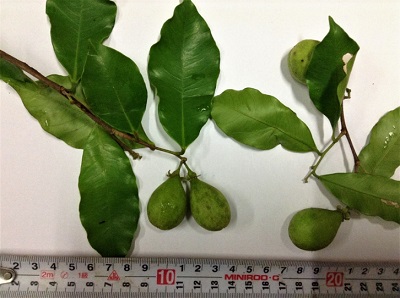Home > Research > Research Results > Research Results 2019 > Suitable environments for planting among agarwood-producing tree species (Aquilaria species)
Update:October 30, 2019
Main content starts here.
Suitable environments for planting among agarwood-producing tree species (Aquilaria species)
| Article title |
Growth performance and leaf ecophysiological traits in three Aquilaria species in Malaysia. |
|---|---|
| Author (affiliation) |
Tanaka Kenzo (a)、Reiji Yoneda (b)、Ayumi Tanaka-Oda (a)、Mohamad Alias Azani (c) (a) Department of Department of Plant Ecology, FFPRI, Tsukuba, Ibaraki, Japan. (b) Shikoku Research Center, FFPRI, Kochi, Japan. (c) Faculty of Forestry Universiti Putra Malaysia, Serdang, Malaysia. |
| Publication Journal |
New Forests、50(5):699-715、Springer、September 2019 DOI:10.1007/s11056-018-09693-7( External link ) |
| Content introduction |
Agarwood-producing trees (Jinkouboku in Japanese, genus Aquilaria, family Thymelaeaceae), which are widely distributed across the tropical forests in Southeast Asia, are highly prized as fragrant wood and perfume ingredients, and it has been traded at high prices since ancient times. Although natural resources of agarwood trees have been depleted because of excessive logging and reforestation has been necessary to recover these resources, there is almost no basic ecological information available on the suitable environments for planting and growing these trees. Therefore, the present study aimed to compare the growth and ecophysiological characteristics (such as photosynthesis) of the seedlings of three typical species of agarwood-producing trees in an environment wherein they experience stress from different harsh conditions, such as high temperatures, strong light, and drought. The findings showed that the resistance to drought differed greatly among the three species. In addition, there was a correlation between the environments of interspecific natural habitat and their stress resistance. Aquilaria hirta, which is distributed along ridge, has thick and hairy leaves, and more than half of its seedlings survived even under high temperatures and drought condition. Conversely, A. subintegra, which grows in the moist environment of forest interiors, has thin leaves and low resistance to desiccation, and almost all of its seedlings withered under the stressful conditions. The characteristics of A. malaccensis, which grows scattered on slopes, has intermediate with those of the other two species. These findings should help in choosing the most suitable environment for planting these agarwood-producing trees and evaluating the risk of damage caused by frequent occurrence of drought as a result of future climate. change.
Figures1:Agarwood sold in Southeast Asia (left) and the essential aromatic oil extracted from it (right) Rosin deposits in the xylem tissues of agarwood-producing trees in response to stimuli, including damage caused by diseases and harmful insects. The affected parts emit a pleasant fragrance when burned and therefore have significant value since ancient times. Even today, agarwood is very popular in China, Japan and the Islamic world, and 1 g of the highest-grade tree, called eaglewood (kyara in Japanese), can be traded at prices higher than 10000 yen. A large piece of agarwood—known as Ranjatai—is housed in Shosoin, Nara, Japan and it has been reported that people in power, including Nobunaga Oda (1534-1582), have cut some pieces from this tree.
Figures2:Branches and leaves of Aquilaria malaccensis used in the present study |
Copyright © Forest Research and Management Organization. All rights reserved.


